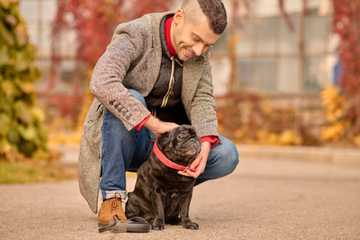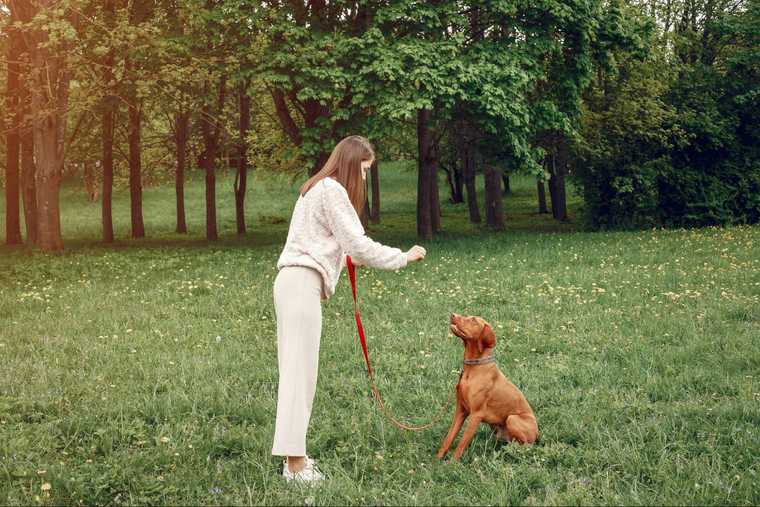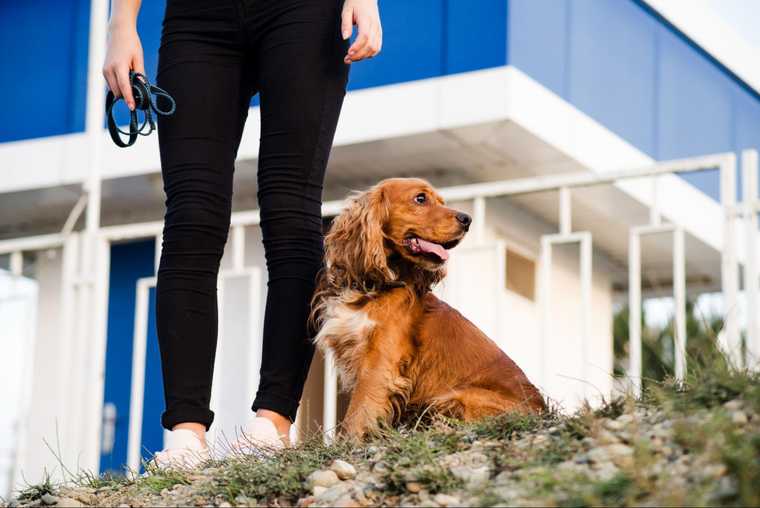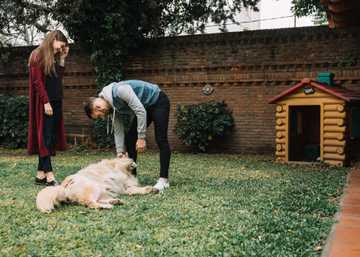Dog "Heel" Command: Everything You Should Know About It

Walking a dog on a leash can be challenging if your dog’s leash manners need improvement. Pulling and dragging the leash isn’t something you have to put up with. You can easily teach your furry friend the command “Heel” to make your walks more enjoyable and safe. It helps them learn better self-control even when off-leash. Read on to learn all about heel training!
What Does the Dog Command “Heel” Mean?
Dog trainers define it as a specific type of dog walking when the dog remains in the owner’s periphery. After hearing the “Heel” cue, the dog comes to the owner, and they start walking together, with the dog staying on the owner’s left side. The dog should align their head and shoulder with the owner’s left hip if appropriately taught.
The dog’s heel position can vary slightly. Thus, your puppy can walk close to you (around 6 inches distance) or a few inches ahead/behind. However, your walks should align.
Benefits of “Heel” Dog Command Training
Some of the main reasons why owners decide to teach their dogs the heel position include:
- Teaching the dog self-control:
This command helps the dog better control their impulses, allowing you to predict their behavior in different circumstances.
- Stopping leash-pulling:
When a dog starts walking calmly next to you, teaching them to walk on a loose leash without pulling it is essential. Although walking in the heel position for an entire walk is not expected or even beneficial for a dog.

- Teaching the dog to walk off-leash:
When your dog masters the heel position, you can expect them to stay close to you during walks and start walking without a leash.
- Providing an alternative to the recall command:
You can use this command to make a dog come to you. It often serves as an emergency recall in dangerous situations.
- Providing mental stimulation to a dog:
Acquiring the command helps the dog form new neural connections and build necessary associations between the cue and the desired behavior. It contributes to daily mental stimulation, keeping the dog’s brain busy.
Popular "Heel" Techniques
We will introduce you to three popular techniques. These methods use positive reinforcement to encourage your dog to stay by your side. You should prepare the rewards and praise for following the command in advance.
How to train a puppy to heel using a clicker
- Position your puppy to the left side of your body while holding a clicker in your right hand.
- Give the command “Sit!” and wait until your puppy sits calmly beside you.
- Click to mark the behavior and offer a treat.
- Next, hold another treat in your hand and lure your dog into walking while saying, ”Heel”!
- When the puppy starts walking, keep the treat next to your body so that the dog follows it close to you. Take a few steps before you click and reward the puppy.
- Gradually fade the lure to make your puppy walk next to you without a treat in your hand. Then, increase the distance of your walks by adding a few steps before clicking and rewarding the puppy.

How to teach “Heel” with the wall method
-
Choose a location where you can walk alongside the wall without distractions.
-
Position the dog between you and the wall and make the dog sit.
-
Give the command “Heel” and start walking along the wall. The dog is likely to follow you at this point.
-
Take a few steps and praise/reward the dog for following the cue.
-
Practice every day in short sessions and gradually increase the distance.
-
When the dog consistently follows the command, you can move away from the wall and practice it in open space. Once your dog has mastered the cue, repeat the learning process without the wall.

How to teach your puppy to heel off-leash
-
Start the training in a spacious but protected area so the dog can’t run away. Consider using a long line to start and ensure safety.
-
Get your puppy in the sitting position so that the dog faces forward to your left side.
-
With a treat in your left hand, give the “Heel” command and lure the dog into walking by keeping the treat in front of the puppy’s nose.
-
Stop and encourage your dog to sit by using the treat you keep in your right hand – praise and repeat following this sequence of actions.
-
Keep practicing and gradually increase the pace of your walk.

Dog Heel Position and Side
The traditional heel side is the left, and it's essential for proper dog obedience in competitions. This tradition also stems from a historical context: dogs were used in hunting and the military.
Nowadays, however, the norm reflects the practicality of walking a dog and managing their behavior with your dominant (for most people, right) hand. Thus, you can use your dominant hand to give hand signals or adjust the leash. In addition, if you walk your fluffy friend in busy city areas, positioning the puppy to the left prevents collision with other passers-by.

If you plan to proceed with professional training, teaching your dog to stay on your left side is beneficial since it’s a unified norm for most trainers. The same is true for dog competitions, where a unified approach dominates.
Finally, many homeowners choose to position their dogs to the left when teaching the dog the “Heel” command because it prevails in the dog training sphere. They simply don’t question the norm and go along with it.
Note: If you don’t plan to work with a professional trainer or put your fluffy friend in other unified training settings, you can teach the “Heel” command by positioning the dog on the more convenient side.
Importance of Loose Leash
Teaching a dog to heel while off-leash adds a new level of complexity. However, once your dog masters the heel training, you can teach them to do it. Releasing your dog to roam freely and sniff around will provide much-needed mental and sensory stimulation.
Remember to be mindful of the environment where you allow your puppy to walk off-leash. Ensure the area is safe and you obey local rules and regulations regarding puppy walking.

Proofing the “Heel” Command
Teaching your puppy to respond consistently to “Heel” is essential. The “Heel” cue will often work as a reliable method to bring your dog back to you when there’s a danger. So, once you train your dog to heel, it’s time to start proofing the training.
Bring your furry friend to as many various locations as possible. You can practice in your backyard, a park, or a training class. The aim is to teach your dog to respond to the “Heel” command regardless of the environment and distractions.
Training Tools and Equipment
You should prepare in advance to teach your puppy the “Heel” command. Some items you need to buy in advance or introduce your dog to (like a clicker).

To teach the “Heel” command to a dog, you need:
- Dog treats to use as rewards
- A clicker to mark the desired behavior
- A leash
- A proper location, depending on the method you choose
- Patience and determination
When to Start Dog Heel Command Training
You can start teaching your puppy to heel early on. At 8-10 weeks, your dog is ready to grasp basic obedience commands so that you can begin the process. Since puppies are eager to explore and learn more about the world, the training should be easy to manage.
Teaching a puppy to heel helps establish good walking habits that keep the dog safe and reduce your stress during the walks.
Wrap Up
Heel training is not necessary. However, many owners choose to do so as it helps manage dogs better during the walks and avoid potentially dangerous situations. You can choose from various techniques to achieve the best results. However, remember to stay consistent and patient and use positive reinforcement to ensure training success.

Passionate team dedicated to help pet owners raise safe and obedient dogs, fostering meaningful connections with their furry companions.

Certified dog trainer, exclusive positive reinforcement methods & tackling aggression problems.